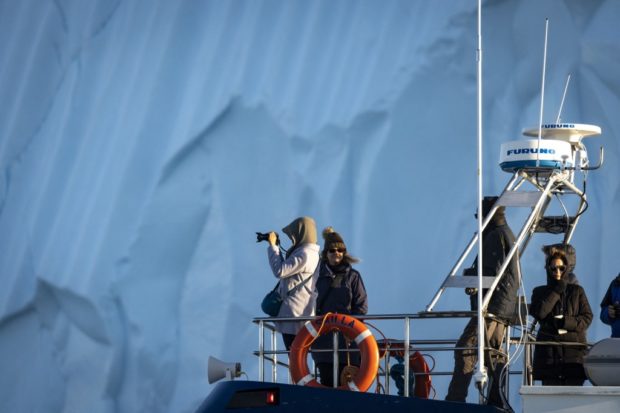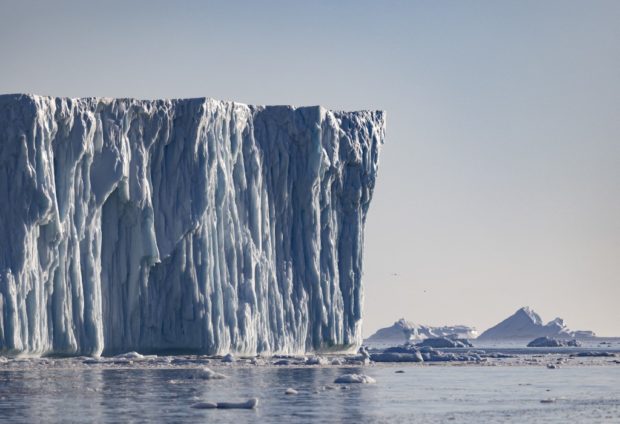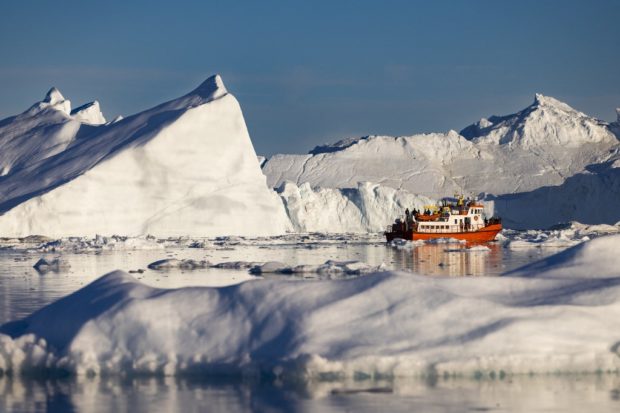Greenland treads softly on tourism as icebergs melt

(FILES) In this file photo taken on July 1, 2022 tourists stand on the deck of a boat manoeuvring among icebergs floating in Disko Bay, Ilulissat, western Greenland. (Photo by Odd ANDERSEN / AFP)
Ilulissat, Denmark — As tourists flock to Greenland to take in its breathtaking icebergs and natural beauty, authorities are mulling ways to control crowds to protect the fragile environment, already threatened by global warming.
“It’s a dream destination,” said Yves Gleyze, a veteran off-the-beaten-track French tourist in his 60s as he arrived at the airport in Ilulissat.
Visitors to the third-biggest town in the Danish autonomous territory are met by a rugged, austere landscape of grey rock and sparse vegetation.
But mesmerizing views of massive icebergs come into view after just a short drive.
Breaking off from the Ilulissat glacier in the neighboring fjord, the majestic blocks of ice drift slowly by in Disko Bay, the occasional whale making an appearance.
Article continues after this advertisementThe postcard views attracted 50,000 tourists in 2021, more than 10 times the town’s population.
Article continues after this advertisementMore than half make only a short pit stop during an Arctic cruise.
Numbers are expected to swell with the opening of an international airport in the next two years, a welcome boost to the island’s revenues but also a challenge, given the delicate — and melting — ecosystem.

(FILES) In this file photo taken on June 30, 2022 an iceberg floats in Disko Bay, Ilulissat, western Greenland. (Photo by Odd ANDERSEN / AFP)
‘Icebergs getting smaller’
In the past 40 years, the Arctic has warmed nearly four times faster than the rest of the planet, according to a recent scientific study.
“We can see changes every day caused by climate change: the icebergs are getting smaller, the glacier is retreating,” said mayor Palle Jeremiassen.
Thawing permafrost is also threatening the stability of some buildings and infrastructure.
With the immaculate landscape so coveted by tourists changing, officials are determined to protect it without turning away tourists.
“We want to control the arrival of tourist ships here,” said Jeremiassen, noting the risks posed by the highly-polluting vessels.
In order to protect the environment and community, Ilulissat should only welcome “one ship max per day, max one thousand tourists per ship,” he said.
Recently, three cruise ships arrived on the same day, spewing out 6,000 visitors.
Jeremiassen said the town’s infrastructure is not designed to accommodate such numbers, nor is it able to ensure that tourists respect protected areas, notably in the fjord.
Nearby Iceland, where the tourism industry has been flourishing for two decades, is an example of how not to do things, he insisted.
“We don’t want to be like Iceland. We don’t want mass tourism. We want to control tourism here. That’s the key we have to find.”

(FILES) In this file photo taken on July 1, 2022 a boat carrying tourists manoeuvres among icebergs floating in Disko Bay, Ilulissat, western Greenland. (Photo by Odd ANDERSEN / AFP)
Small fish
Greenland has enjoyed self-rule since 2009 but hopes to gain full independence from Denmark one day.
To do so means it would have to get by without subsidies from Copenhagen, which currently make up a third of its budget. It has yet to find a way to stand alone financially, and for now, its main natural resource is the sea.
In Ilulissat, one in three locals live off fishing, which accounts for most of Greenland’s revenues.
But climate change is having a big impact.
“Back when I was young we had pack ice we could walk on,” said Lars Noasen, the captain of a tourist boat as he navigated deftly between iceberg debris in Disko Bay.
“Now the pack ice is not so solid anymore. You can’t use it for anything, you can’t dogsled on the ice and fish like in the old days.”
In the past two decades, Greenland’s massive ice cap has lost 4.7 trillion tons of ice, contributing to a sea level rise of 1.2 centimeters on its own, according to Danish Arctic researchers.
The disappearing ice has affected fishermen.
“The ice conditions are changing. The main fjord used to be closed off by huge icebergs and sea ice and they (the fishermen) were not able to sail in before,” said Sascha Schiott, a researcher at the Greenland Institute of Natural Resources.
Now they can.
Boats are also able to head out fishing year-round now, which has increased fishermen’s hauls.
But the size of the fish they’re catching has decreased, largely due to overfishing, says Schiott.
Ejner Inusgtuk, a craggy-faced fisherman preparing his lines in the port, disagreed and said climate change is to blame.
“The climate is too warm.”